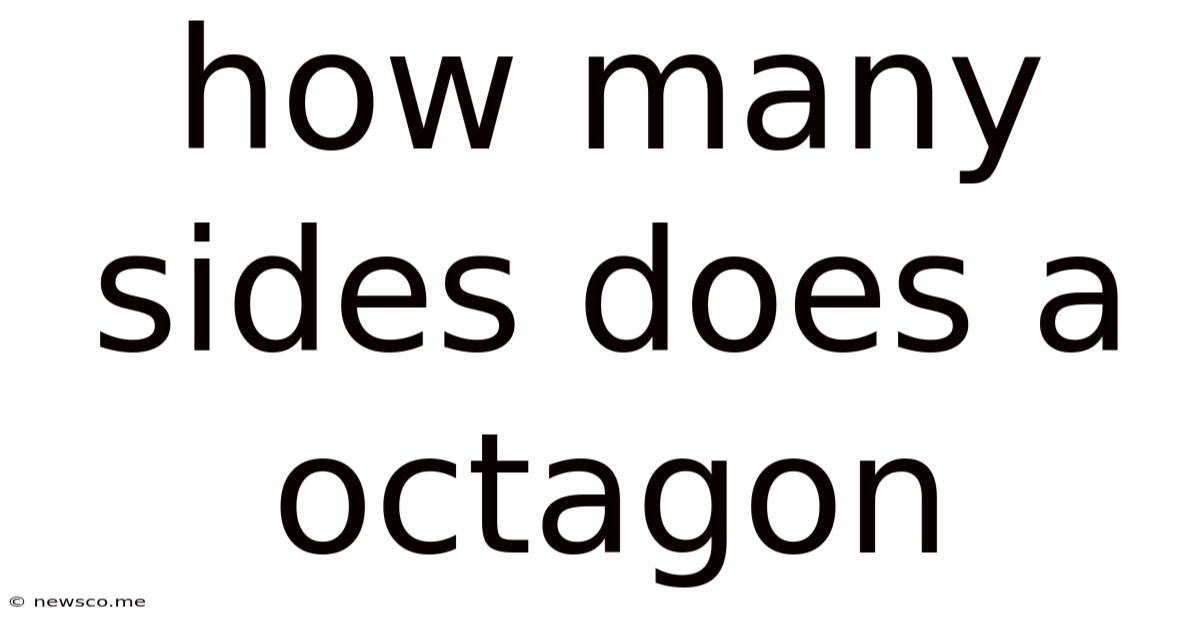How Many Sides Does A Octagon
News Co
Apr 23, 2025 · 4 min read

Table of Contents
How Many Sides Does an Octagon Have? A Deep Dive into Octagonal Geometry
The question, "How many sides does an octagon have?" might seem trivial at first glance. The answer, of course, is eight. However, exploring this seemingly simple question opens a fascinating door into the world of geometry, revealing intriguing properties, diverse applications, and a rich history interwoven with mathematics and art. This article will delve beyond the basic answer, examining the octagon's characteristics, its presence in various fields, and even some surprising connections to other geometric shapes.
Understanding the Octagon: Definition and Basic Properties
An octagon, in its simplest definition, is a polygon with eight sides and eight angles. The word "octagon" itself stems from the Greek words "oktō" (meaning eight) and "gōnia" (meaning angle). This etymology perfectly encapsulates the core definition of the shape.
Regular vs. Irregular Octagons
It's crucial to distinguish between regular and irregular octagons:
-
Regular Octagon: A regular octagon is a perfectly symmetrical figure where all eight sides are of equal length, and all eight angles are equal (each measuring 135°). This regularity leads to inherent properties that make it particularly useful in design and construction.
-
Irregular Octagon: An irregular octagon, in contrast, has sides and angles of varying lengths and measures. Its lack of symmetry makes it more complex to analyze but also allows for greater design flexibility.
Calculating the Properties of a Regular Octagon
The regularity of a regular octagon allows for straightforward calculations of its various properties. Here are some key formulas:
1. Interior Angles:
The sum of the interior angles of any polygon with n sides is given by the formula (n-2) * 180°. For an octagon (n=8), the sum of interior angles is (8-2) * 180° = 1080°. Since a regular octagon has equal angles, each interior angle measures 1080° / 8 = 135°.
2. Exterior Angles:
Each exterior angle of a regular octagon is supplementary to its corresponding interior angle. Therefore, each exterior angle measures 180° - 135° = 45°. The sum of all exterior angles of any polygon always equals 360°.
3. Area:
Calculating the area of a regular octagon requires knowing the length of its side (s). The formula is:
Area = 2(1 + √2)s²
This formula highlights the elegant mathematical relationship between the side length and the area of a regular octagon.
4. Apothem:
The apothem (a) of a regular polygon is the distance from the center to the midpoint of any side. For a regular octagon, the apothem is related to the side length by:
a = s(1 + √2) / 2
This relationship allows for the calculation of the apothem given the side length, or vice-versa.
Octagons in the Real World: Applications and Examples
Octagons, both regular and irregular, appear frequently in various real-world contexts:
1. Architecture and Design:
- Stop Signs: The iconic octagonal shape of stop signs is perhaps the most widely recognized example of an octagon's application. The unique shape makes it highly visible and easily distinguishable.
- Buildings and Structures: Octagonal designs are found in some buildings and structures, offering unique aesthetic qualities and sometimes providing structural advantages.
- Tessellations: Octagons, along with other polygons, can be used to create intricate tessellations, or repeating patterns that cover a plane without gaps or overlaps.
2. Nature:
While not as prevalent as triangles or hexagons, octagonal patterns can sometimes be found in natural formations, though often imperfectly. Crystal structures and certain biological formations might exhibit octagonal characteristics.
3. Art and Crafts:
Octagons are used in various artistic creations, from stained glass windows to intricate geometric designs in textiles and other crafts. The symmetry and visual appeal of the regular octagon make it a popular choice for artists.
Octagons and Other Geometric Shapes: Interesting Relationships
The octagon's geometry intertwines with other shapes in interesting ways:
- Squares: An octagon can be constructed by cutting off the corners of a square. This process reveals a connection between the two shapes.
- Triangles: A regular octagon can be subdivided into eight isosceles triangles, each sharing a common vertex at the center of the octagon.
- Circles: A regular octagon can be inscribed within a circle, and a circle can be circumscribed around a regular octagon. These relationships highlight the connection between circular and octagonal geometry.
Beyond the Basics: Exploring Advanced Octagonal Geometry
The study of octagons goes far beyond the basic calculations mentioned earlier. More advanced concepts include:
- Star Octagons: These are created by extending the sides of a regular octagon to form a star-like shape.
- Truncated Octagons: These are created by truncating, or cutting off, the corners of a regular octagon.
- Octagonal Prisms and Pyramids: Three-dimensional shapes incorporating octagons as their bases.
Conclusion: The Enduring Significance of the Octagon
While the answer to "How many sides does an octagon have?" is straightforward, the exploration of octagonal geometry reveals a wealth of mathematical concepts, real-world applications, and aesthetic appeal. From the humble stop sign to intricate architectural designs and artistic creations, the octagon's eight sides contribute to a fascinating story of geometry in our world. Its unique properties and relationships with other shapes continue to inspire mathematicians, designers, and artists alike. The seemingly simple question of its number of sides unveils a much richer and more complex understanding of geometric principles.
Latest Posts
Related Post
Thank you for visiting our website which covers about How Many Sides Does A Octagon . We hope the information provided has been useful to you. Feel free to contact us if you have any questions or need further assistance. See you next time and don't miss to bookmark.